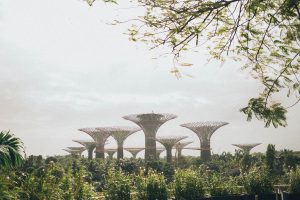In the modern age, steel and concrete have become two of mankind’s greatest discoveries; cities and nations have been built solely using these materials, and as such can be found in infrastructure both simple and complex. As more of the world comes to realize the dangers of pollution, however, changes are being made to our standard manufacturing processes. As a result, many eco-friendly builders are replacing these modern industrial materials with a far simpler one: wood. One architectural firm has decided to abandon these tried-and-true (but dirty) materials for a cleaner, greener option: bamboo.
Typically, wood is not an eco-friendly material because of the effects of deforestation. Fortunately, that’s hardly a concern with bamboo wood in particular. Made from natural vegetation that grows to maturity in as little as three to five years, bamboo is a renewable and exceptionally durable resource. Both of these qualities make it a perfect choice for Eleena Jamil Architect, a Cyberjaya-based architectural firm, to use as a base material in their Bamboo Terrace Homes. The locally harvested bamboo presents as an eco-friendly option for mass contemporary housing.
“Use of bamboo in house design is limited to two extremes: either as temporary low-cost homes in poor, mainly rural areas, or as one-off houses located almost invariably in beautiful exotic sites and locations,” reads the firm’s website. “In this proposal, the underlying idea is to demonstrate that it is possible to build permanent and comfortable contemporary homes in urban and suburban areas for the masses using local natural material such as bamboo. It intends to propel the idea of bamboo as a modern and everyday construction material just like bricks, steel, or concrete.”
The prefabricated structural frames can be mass-produced and flat-packed to reduce costs and the environmental impact, yet the homes are still beautiful. They’re designed to reflect a typical Malaysian terrace house, characteristic of 22-foot wide frontages that overlook onto the street. The main structure is wholly bamboo (except for the bathroom enclosures which must be made of concrete to contain the wet areas and keep moisture away from the structural bamboo components). The internal and external walls are lightweight bamboo composite board system, whereas floors will be covered with engineered bamboo floorboards.
Although the proposal is still in the conceptual phase, hopes remain high that the design will inspire developers and the local government to adopt bamboo as a sustainable building material.
Concrete is an extremely strong material. Concrete can achieve compression forces equivalent to 20,000 psi, although most concrete can only withstand 3,000 to 7,000 psi. That being said, modern builders — and their clients — are changing their priorities. And in our green new world, the eco-friendly properties of bamboo may just win out over more modern materials.


